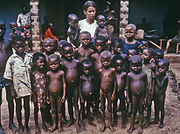
Stunted growth
Encyclopedia


Malnutrition
Malnutrition is the condition that results from taking an unbalanced diet in which certain nutrients are lacking, in excess , or in the wrong proportions....
in early childhood
Childhood
Childhood is the age span ranging from birth to adolescence. In developmental psychology, childhood is divided up into the developmental stages of toddlerhood , early childhood , middle childhood , and adolescence .- Age ranges of childhood :The term childhood is non-specific and can imply a...
, including malnutrition during fetal development brought on by the malnourished mother. In developing countries
Developing country
A developing country, also known as a less-developed country, is a nation with a low level of material well-being. Since no single definition of the term developing country is recognized internationally, the levels of development may vary widely within so-called developing countries...
, stunted growth is a common problem affecting a large percentage of children. Once established, stunting and its effects typically become permanent. Stunted children may never regain the height lost as a result of stunting, and most children will never gain the corresponding body weight. It also leads to premature death later in life because vital organs never fully develop during childhood.
Identification
Growth stunting is identified by comparing measurements of children's heights to the NCHSNational Center for Health Statistics
National Center for Health Statistics is a division of the United States federal agency the Centers for Disease Control and Prevention . As such, NCHS is under the United States Department of Health and Human Services...
growth reference population: children who fall below the fifth percentile
Percentile
In statistics, a percentile is the value of a variable below which a certain percent of observations fall. For example, the 20th percentile is the value below which 20 percent of the observations may be found...
of the reference population in height for age are defined as stunted, regardless of the reason. As an indicator of nutritional status, comparisons of children's measurements with growth reference curves may be used differently for populations of children than for individual children. The fact that an individual child falls below the fifth percentile for height for age on a growth reference curve may reflect normal variation in growth within a population: the individual child may be short simply because both his parents carried gene
Gene
A gene is a molecular unit of heredity of a living organism. It is a name given to some stretches of DNA and RNA that code for a type of protein or for an RNA chain that has a function in the organism. Living beings depend on genes, as they specify all proteins and functional RNA chains...
s for shortness and not because of inadequate nutrition. However, if substantially more than 5% of an identified child population have height for age that is less than the fifth percentile on the reference curve, then the population is said to have a higher-than-expected prevalence of stunting, and malnutrition is generally the first cause considered.
Example
One study conducted in a rural area in ZimbabweZimbabwe
Zimbabwe is a landlocked country located in the southern part of the African continent, between the Zambezi and Limpopo rivers. It is bordered by South Africa to the south, Botswana to the southwest, Zambia and a tip of Namibia to the northwest and Mozambique to the east. Zimbabwe has three...
illustrates the impact malnutrition has on growth. The area is known for poor farming conditions and prevalent malnourishment. Children ages 6–17 in the area were assessed for height, weight, and body mass index
Body mass index
The body mass index , or Quetelet index, is a heuristic proxy for human body fat based on an individual's weight and height. BMI does not actually measure the percentage of body fat. It was invented between 1830 and 1850 by the Belgian polymath Adolphe Quetelet during the course of developing...
(BMI). The data recorded was compared with both American and other African countries average heights. Compared with the American averages, the Zimbabwean boys’ height and weight dropped as low as the 10th percentile in some age groups and showed no sign of catch-up growth during the mid-teens. Zimbabwean girls’ height and weight were not as low, but did drop as low as the 25th percentile. However, catch-up growth did occur during mid-teens and by 16 and 17, the girls average was close to the 50th percentile. Olivier, Semproli, Pettener, and Toselli, sums it up by saying that “the adverse socioeconomic environment and the low levels of food availability compromise and probably delay the physical development of the affected children in all phases of growth.” Also, these data support the theory that lower than average size at early ages could be due to an adaptive mechanism reacting to low food intake.

